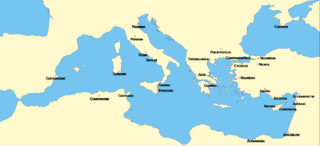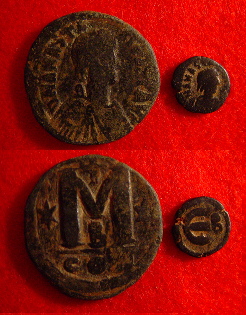 W
WThe aspron, from Latin asper, was a late Byzantine name for silver or silver-alloy coins.
 W
WThe as, occasionally assarius was a bronze, and later copper, coin used during the Roman Republic and Roman Empire.
 W
WThe basilikon, commonly also referred to as the doukaton, was a widely circulated Byzantine silver coin of the first half of the 14th century. Its introduction marked the return to a wide-scale use of silver coinage in the Byzantine Empire, and presaged the total abandonment of the gold coins around the middle of the century.
 W
WIn the Middle Ages, the term bezant was used in Western Europe to describe several gold coins of the east, all derived ultimately from the Roman solidus. The word itself comes from the Greek Byzantion, ancient name of Constantinople, the capital of the Byzantine Empire.
 W
WThe follis was a type of coin in the Roman and Byzantine traditions.
 W
WThe hexagram was a large silver coin of the Byzantine Empire issued primarily during the 7th century AD.
 W
WHistamenon was the name given to the gold Byzantine solidus when the slightly lighter tetarteron was introduced in the 960s. To distinguish the two, the histamenon was changed in form from the original solidus, becoming wider and thinner, as well as concave (scyphate) in form. Later usually shortened to stamenon, it was discontinued after 1092. In the 12th and 13th centuries, the name stamenon came to be applied to the concave billon and copper trachea coins.
 W
WThe hyperpyron was a Byzantine coin in use during the late Middle Ages, replacing the solidus as the Byzantine Empire's gold coinage.
 W
WThe michaelaton, in Latin michaelatus, was the colloquial name given to the gold Byzantine coins (nomismata) struck by any emperor called Michael.
 W
WThe miliarense was a large silver coin, introduced to the late Roman monetary system in the early 4th century. It was struck with variable fineness, generally with a weight between 3.8 and 6.0 grams, and a diameter of c. 23–24 mm. The miliarense was struck first under Constantine the Great.
 W
WThe miliaresion, is a name used for two types of Byzantine silver coins. In its most usual sense, it refers to the themed flat silver coin struck between the 8th and 11th Century.
 W
WThe East Roman or Byzantine Empire established and operated several mints throughout its history (330–1453). Aside from the main metropolitan mint in the capital, Constantinople, a varying number of provincial mints were also established in other urban centres, especially during the 6th century. Most provincial mints except for Syracuse were closed or lost to invasions by the mid-7th century. After the loss of Syracuse in 878, Constantinople became the sole mint for gold and silver coinage until the late 11th century, when major provincial mints began to re-appear. Many mints, both imperial and, as the Byzantine world fragmented, belonging to autonomous local rulers, were operated in the 12th to 14th centuries. Constantinople and Trebizond, the seat of the independent Empire of Trebizond (1204–1461), survived until their conquest by the Ottoman Turks in the mid-15th century.
 W
WNummus, plural nummi (νοῦμμοι) is a Latin term meaning "coin", but used technically by modern writers for a range of low-value copper coins issued by the Roman and Byzantine empires during Late Antiquity. It comes from the Greek nomos via its Western Doric form noummos, which was used to describe a coin in some parts of southern Italy. The word was also used during the later years of the Roman Republic and the early Empire, either as a general word for a coin, or to describe the sestertius, which was the standard unit for keeping accounts.
 W
WThe politikon coinage is a series of Byzantine billon coins, struck around the middle of the 14th century, which are distinguished by the Greek inscription +ΠΟΛΙΤΙΚΟΝ.
 W
WThe solidus, nomisma, or bezant was a highly pure gold coin issued in the Late Roman Empire and Byzantine Empire. Constantine introduced the coin, and its weight of about 4.5 grams remained relatively constant for seven centuries. In the Byzantine Empire, the solidus or nomisma remained a highly pure gold coin until the 11th century, when several Byzantine emperors began to strike the coin with less and less gold. The nomisma was finally abolished by Alexius I in 1092, who replaced it with the hyperpyron, which also came to be known as a "bezant". The Byzantine solidus also inspired the originally slightly less pure dinar issued by the Muslim Caliphate. In Western Europe, the solidus was the main gold coin of commerce from late Roman times to Pepin the Short's currency reform, which introduced the silver-based pound/shilling/penny system.
 W
WThe term trachy, plural trachea (τραχέα), meaning "rough" or "uneven", was used to describe the cup-shaped Byzantine coins struck in the 11th–14th centuries. The term was properly applied to coins of electrum, billon, or copper, and not to the gold hyperpyra.
 W
WThe tremissis or tremis was a small solid gold coin of Late Antiquity. Its name, meaning "a third of a unit", formed by analogy with semissis, indicated its value relative to the solidus. It was introduced into Roman currency in the 380s by the Emperor Theodosius I and initially weighed 8 siliquae.